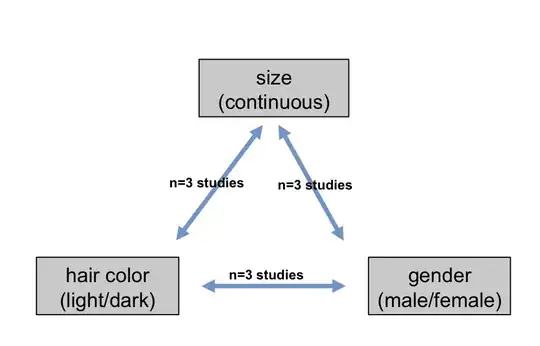I would like to conduct a meta-analysis to investigate the interaction of three variables:hair color (dark/light), gender (male/female) and size (continuous).

I have three studies reporting effect sizes for the difference in size between light and dark hair:
my_data_1 <- data.frame(studies = c("study_1","study_2","study_3"),
group_1 = c(rep("light_hair",3)),
group_2 = c(rep("dark_hair",3)),
outcome = c(rep("size", 3)),
smd = c(1.2,1.3,0.8),
var_smd = c(0.2,0.23,0.15))
> my_data_1
studies group_1 group_2 outcome smd var_smd
1 study_1 light_hair dark_hair size 1.2 0.20
2 study_2 light_hair dark_hair size 1.3 0.23
3 study_3 light_hair dark_hair size 0.8 0.15
Three studies reporting effect size for the difference in size between male and female:
my_data_2 <- data.frame(studies = c("study_4","study_5","study_6"),
group_1 = c(rep("male", 3)),
group_2 = c(rep("female", 3)),
outcome = c(rep("size", 3)),
smd = c(1.8,0.9,1.55),
var_smd = c(0.25,0.35,0.1))
> my_data_2
studies group_1 group_2 outcome smd var_smd
1 study_4 male female size 1.80 0.25
2 study_5 male female size 0.90 0.35
3 study_6 male female size 1.55 0.10
Three studies reporting effect sizes for the difference in gender between light and dark hair:
my_data_3 <- data.frame(studies = c("study_7","study_8","study_9"),
light_male = c(10,10,20),
light_female = c(5,7,12),
dark_male = c(15,7,14),
dark_female = c(19,21,25))
my_data_3 <- escalc(ai=light_male, bi=light_female, ci=dark_male,
di=dark_female, data=my_data_3, measure="OR2D")
> my_data_3
studies light_male light_female dark_male dark_female yi
1 study_7 10 5 15 19 0.5125
2 study_8 10 7 7 21 0.8023
3 study_9 20 12 14 25 0.6013
vi
1 0.1275
2 0.1317
3 0.0744
All studies represent independent samples!
I would like to set up one multivariate meta-analytic model to investigate the mutual influence of the three factors hair color, gender and size. Could somebody point me to potential statistical approaches to this as well as potential implementations in R (metafor, gemtc, metaSEM)?